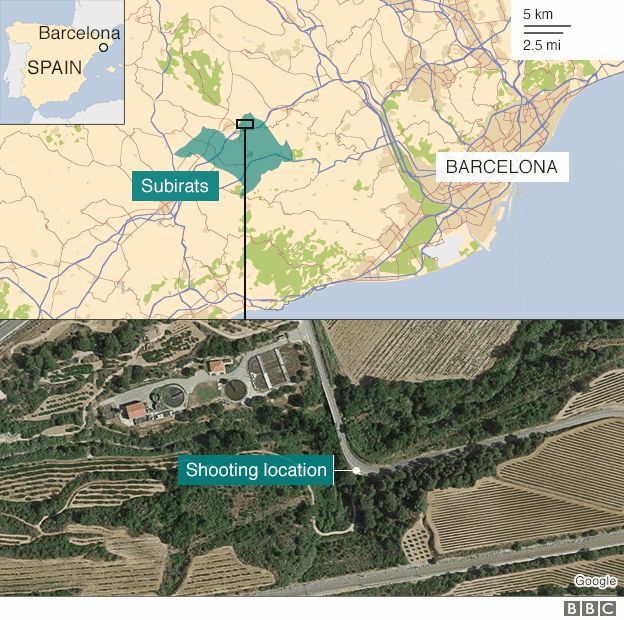Spanish police have confirmed the man shot in an operation outside Barcelona is Younes Abouyaaqoub - the chief suspect in the van attack in the city last Thursday.
Wearing a fake explosive belt, he was shot in the Subirats area, close to Sant Sadurní d'Anoia, police say.
Police reportedly closed in after a witness saw someone fitting his description near a petrol station.
The van attack on Las Ramblas avenue killed 13 and injured more than 100.
Media reports quoting police sources said Abouyaaqoub had shouted "Allahu Akbar" ("God is Greatest") when confronted.
The operation took place some 25 miles (40km) from Barcelona.
Bomb disposal officers went to the scene with a robot to examine what reports suggest may be a fake explosive belt.
Police have not confirmed reports in some Spanish media that Abouyaaqoub is dead, confining themselves to saying he was "shot down".

Escape
At an earlier news conference, police described how after the attack Abouyaaqoub made his escape on foot to the outskirts of the city where he hijacked a car.
CCTV footage in Spanish media appears to show him walking through a market district shortly after the attack.
Some 90 minutes after mowing down dozens of people on the central Las Ramblas avenue, Abouyaaqoub fled to the city's university district, police said.
Abouyaaqoub is alleged to have hijacked the car before driving it through a police checkpoint and later abandoning the vehicle. Police say he may have crossed into France.
The male driver of the car, Pau Pérez, 34, from Vila Franca, was found stabbed to death in the back seat, becoming the 15th victim of the Barcelona bloodshed and a later attack in the resort of Cambrils.
A woman died in Cambrils when a car was driven into pedestrians and five suspected jihadists were killed at the scene by police.
On Monday officials also revealed there were "strong indications" that an imam suspected of radicalising the young men who carried out the attacks had died in an explosion at a house in Alcanar, south of Barcelona, that was being used as a bomb factory.

Catalan officials said that all 15 victims had now been identified and their families notified.
In addition to the five suspects killed in Cambrils, four others are under arrest.
Two sets of human remains are yet to be identified from the house that blew up last Wednesday night.
Family members of the dead suspects said they believed Imam Es Satty had radicalised several young people in their home town of Ripoll, north of Barcelona.
Spanish media outlets say he had spent some time in prison, and had met prisoners involved or linked with the 2004 Madrid train bombings in which 191 people died.
He had also stayed in Belgium for some three months last year, where he had been searching for work, including in Vilvoorde, a small town of just 42,000 from which more than 20 jihadists departed for Syria in 2014.
An official who works on de-radicalisation in Belgium has told the BBC that Es Satty tried to secure a post at a mosque near Brussels but the elders decided he should not be allowed to preach due to his "radicalised and polarising" approach.
The mosque asked police to perform a background security check but this did not throw up any specific areas of concern.
The 12-strong Spanish cell had apparently been planning three co-ordinated attacks using home-made bombs. Police found about 120 gas canisters at the Alcanar site.
So-called Islamic State (IS) said it had carried out the Las Ramblas and Cambrils attacks, though it is not clear whether any of the attackers were directly connected to the group or simply inspired by it.
Source: BBCNews



No comments:
Post a Comment
Add a Comment...